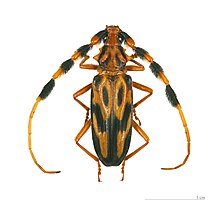| Cerambycidae Temporal range:
| |
|---|---|

| |
| Batus barbicornis | |
| Scientific classification | |
| Domain: | Eukaryota |
| Kingdom: | Animalia |
| Phylum: | Arthropoda |
| Class: | Insecta |
| Order: | Coleoptera |
| Superfamily: | Chrysomeloidea |
| Family: | Cerambycidae Latreille, 1802 [1] |
| Subfamilies | |
|
Eight; see text | |
The longhorn beetles (Cerambycidae), also known as long-horned or longicorns (whose larvae are often referred to as roundheaded borers), are a large family of beetles, with over 35,000 species described.[2]
Most species are characterized by antennae as long as or longer than the beetle's body. A few species have short antennae (e.g., Neandra brunnea), making them difficult to distinguish from related families such as Chrysomelidae. "Cerambycidae" comes from a Greek mythological figure: after an argument with nymphs, the shepherd Cerambus is transformed into a large beetle with horns.
Longhorn beetles are found on all continents except Antarctica.[3]
- ^ "Cerambycidae Latreille, 1802". Integrated Taxonomic Information System. Retrieved June 6, 2011.
- ^ "Cerambycidae - Longhorn beetles | NatureSpot".
- ^ Rossa, R.; Goczał, J. (2021-01-01). "Global diversity and distribution of longhorn beetles (Coleoptera: Cerambycidae)". The European Zoological Journal. 88 (1): 289–302. doi:10.1080/24750263.2021.1883129. ISSN 2475-0263.